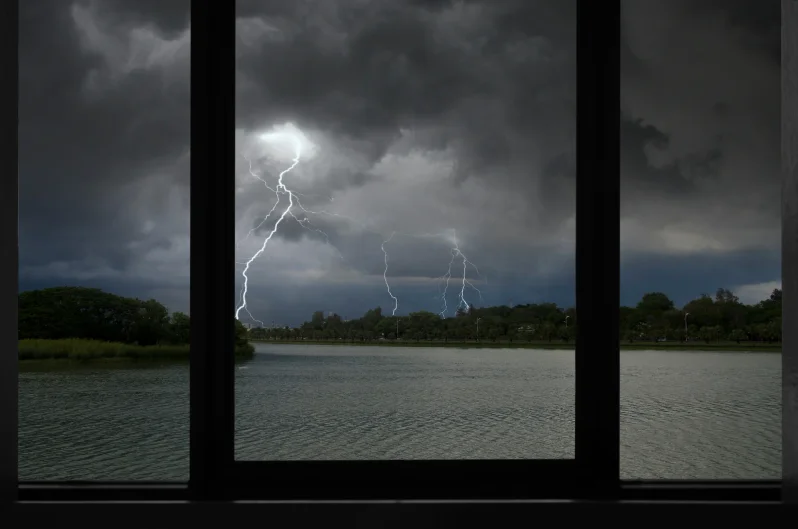Can You Pass This Hurricane Quiz?

Here's a quick true or false hurricane quiz for y'all:
1) True or false: Cyclones rotate clockwise in the Northern Hemisphere and counter-clockwise in the Southern Hemisphere.
2) True or false: The minimum sustained wind speed to qualify for a hurricane is 65 miles per hour.
3) True or false: A hurricane is said to make landfall when its outer bands reach a shoreline.
4) True or false: Storm tide and storm surge mean the same thing.
Scroll to the bottom to check your answers + Download your Hurricane Preparedness Checklist HERE

Today I'd like to familiarize you with terms used by weather experts when referring to hurricanes.
There are many of them, so I'll only mention some. But this way you'll know what they're talking about when you hear these terms mentioned.
Categories refer to wind speeds
Let's start off with hurricane categories. They can't tell you exactly what the results of the storm will be in your area, but they can give you an indication of what you might expect.
Hurricanes are measured on the Saffir-Simpson Hurricane Wind Scale, ranging from Category 1 to Category 5. The scale was developed by engineer Herbert Saffir and meteorologist Robert Simpson.
These categories only factor in the wind speeds of a hurricane. The amount of water the storm produces and the speed at which the storm travels are separate factors.
In other words, categories won't tell you how much destruction and flooding will occur, but they will give you a pretty good idea of both.
Hurricane Categories: What They Really Mean for You
Hurricanes are ranked by wind speed—but what does that mean for your home and safety?
- Category 1 (74–95 mph): Minor damage is possible. You might see broken branches, loose shingles, and some flying debris, but most homes stay mostly intact.
- Category 2 (96–110 mph): Power outages are likely. Older mobile homes could be destroyed, and stronger winds can peel off roofs or siding from buildings.
- Category 3 (111–129 mph): This is when things get serious. There’s a real risk of injury or worse. Mobile homes won’t hold up, and even well-built homes may see major damage.
- Category 4 (130–156 mph): Expect severe destruction. Roofs can be ripped off, windows blown out, and entire floors of buildings damaged. Debris can be deadly.
- Category 5 (157+ mph): The worst-case scenario. Most homes—no matter how well-built—won’t stand a chance. Long-term outages, water shortages, and widespread devastation follow.

Coming to terms with hurricanes
Now for some hurricane-specific terms:
A hurricane watch is a 48-hour warning letting you know that a hurricane is possible in your area.
A hurricane warning is a 36-hour notice that the hurricane is expected in your area.
The eye of a hurricane is the roughly circular center where winds are minimal. But if you're in the eye of a hurricane, you'll soon be hit with the devastating winds of the eyewall.
The hurricane eyewall is the ring of clouds and moisture surrounding the eye of the storm. This is where the wind speeds are strongest.
Storm surge is an abnormal rise in the sea level during a hurricane or other storm. When that surge is moving inland, it can cause life-threatening conditions.
Inundation is the flooding of what is normally dry land. Combined with the high winds of a storm, strong waves can result.
A direct hit occurs when the storm passes to within a distance equal to its radius of maximum wind.
An indirect hit occurs when an area experiences hurricane force winds (either sustained or gusts), but the eye remains off-shore.
Rapid intensification occurs when there is an increase in maximum sustained winds of at least 34.5 mph in a 24-hour period.
True-false quiz answers
As promised, here are answers to those true-false questions I posed earlier:
- True or false: Cyclones rotate clockwise in the Northern Hemisphere and counter-clockwise in the Southern Hemisphere. False. Cyclones rotate counter-clockwise in the Northern Hemisphere and clockwise in the Southern Hemisphere.
- True or false: The minimum sustained wind speed to qualify for a hurricane is 65 miles per hour. False. The minimum wind speed to qualify for a hurricane is 74 mph.
- True or false: A hurricane is said to make landfall when its outer bands reach a shoreline. False. Landfall occurs when the eye of the hurricane reaches land.
- True or false: Storm tide and storm surge mean the same thing. False. Storm surge is an abnormal rise in sea level accompanying a hurricane or other intense storm. Storm tide is the actual level of sea water resulting from the astronomic tide combined with the storm surge.
How did you do? All the answers were false, but now I'm going to tell you what's true.
No matter where you live, you need an emergency weather radio to give you advance notice of dangerous weather.

Our Liberty Band Emergency Solar Radio features National Oceanic Atmospheric Administration alerts, with seven 24/7 weather channels and AM/FM and shortwave radio.
It includes an LCD display clock with alarm and an ultra-bright flashlight. We made it lightweight with the ability to recharge with the free power of the sun.
We added a hand crank for emergency starting. We even made sure that it could power up other devices when you need them most. Including your cellphone.
We believe in empowering you to keep yourself and your family safe. Stay informed and stay prepared.
